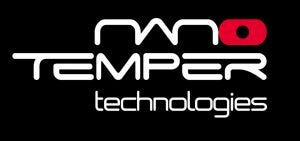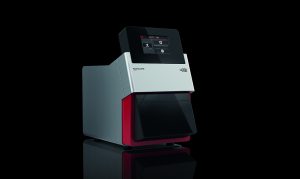- Sponsored Content
Maximize Your Discovery and Development Productivity with Automated nanoDSFMaximize Your Discovery and Development Productivity with Automated nanoDSF
Sponsored by Nanotemper
 Assessment of thermal stability parameters of biologics is an integral part of biopharmaceutical research. The ever-growing number of biologics in development pipelines worldwide demands rapid and precise methods to quickly screen large sets of conditions in an easy and straight-forward manner.
Assessment of thermal stability parameters of biologics is an integral part of biopharmaceutical research. The ever-growing number of biologics in development pipelines worldwide demands rapid and precise methods to quickly screen large sets of conditions in an easy and straight-forward manner.
In a recent study, we compared two methods for detection of thermal unfolding transition temperatures (Tm) of a therapeutic monoclonal antibody (MAb): nanoDSF, which analyzes changes in the fluorescence emission properties of proteins, and differential scanning calorimetry (µDSC), which detects changes in the heat capacity of a protein solution upon unfolding. Both nanoDSF and µDSC provide precise and consistent data. But nanoDSF also overcomes several limitations of µDSC (e.g., low throughput and high sample consumption) and thus represents the ideal technology for rapid and precise thermal stability screening in biopharmaceutical development.

Prometheus NT.Plex nanoDSF instrument
In a second study we demonstrated that nanoDSF can be used to predict long-term stability in only a few hours. The approach uses a combination of thermal and chemical unfolding analysis in a high-throughput setting. Using the Prometheus NT.Plex nanoDSF instrument with aggregation detection optics, we screened five formulations at different MAb concentrations for their thermal and chemical stability. The obtained unfolding data correlates with long-term turbidity and monomer content over time, showing that the Prometheus NT.Plex can be used to predict the long-term stability of biologics rapidly (within one day).
The thermal stability of a protein is used routinely as a main indicator of its physical stability, which affects long-term storage in a given formulation. Historically, µDSC has been used during formulation development. Although typically considered the gold standard for thermal stability measurements, µDSC has several drawbacks. Rigorous equilibration and calibration are required, which precludes parallelization of measurements, and samples must be measured one at a time. Moreover, the concentration range is limited to about 0.5–5 mg/mL MAb. Sample volumes of typically hundreds of microliters (µL) per sample are required, which sum up quickly in screening campaigns. Thus, preselection of conditions is often performed. To optimize a screening procedure for identifying ideal formulation conditions, a higher throughput and lower sample consumption are desired while maintaining precise Tm detection.
The Prometheus instrument fills this gap by analyzing protein unfolding transitions based on high-precision detection of intrinsic fluorescence changes. This truly label-free approach allows for the parallelized detection of up to 48 samples with concentrations ranging from 10 µg/mL to >250 mg/mL without buffer restrictions. It does not require addition of extrinsic fluorescent dyes (like for the classical DSF technique), thereby reducing potential detrimental interactions of dye and protein or excipients. The innovative dual-UV detection method enables rapid scanning of samples, which results in a very high data point density of 20 or more data points per °C, depending on the steepness of the temperature ramp.

Figure 1: Comparison of nanoDSF and m-DSC
To compare the precision and overlap of Tm determination directly by µDSC and nanoDSF, we conducted a small formulation screen using a commercial, therapeutic MAb. We analyzed thermal unfolding of the MAb in 10 different formulations with different buffers and pH values. We also tested polysorbate 20 and 80 (PS20 and PS80, respectively), which are common surfactants in MAb formulations but preclude analysis by orthogonal fluorescence methods such as DSF assays. Both nanoDSF and µDSC produced precise and highly comparable Tm values (Figures 1A and 1B). However, nanoDSF required significantly less sample and time than does µDSC (Figure 1C).
The integrated nanoDSF protocol and innovative capillary format of the Prometheus series instruments overcomes many key limitations of µDSC (Figure 1D). It allows for easy sample handling, even for highly concentrated and very viscous formulation conditions (>50 cP). In addition to its speed, precision, and throughput, nanoDSF is a robust method that does not require cumbersome instrument maintenance or time-consuming sample preparation such as dialysis or filtration.
In a second study, we performed proof-of-concept chemical and thermal denaturation experiments with lysozyme, which is very well characterized in terms of aggregation pathways. Moreover, we analyzed ΔG°app, aggregation onset temperatures (Tagg), and unfolding transition temperatures (Tm) of a MAb in different formulations and compared results with turbidity and monomer content over time as assessed by HPSEC for long-term stability data. For this, we used automated liquid handling in conjunction with capillary-chip filling using the NT.Robotic Autosampler and automated measurement execution by the Prometheus NT.Plex. Results show that this combinatory approach of thermal and chemical denaturation allowed for the identification of the formulation with the best long-term stability.
The obtained data demonstrates that chemical denaturation is a feasible approach to predict the colloidal long-term stability of biologicals. Moreover, changes in ΔG° in dependence of protein concentration can provide immediate feedback of whether protein aggregation occurs and can also be used to discriminate between native- and denatured-state aggregation. Knowledge about the aggregation mechanism is vital to design further steps in a development process.
In summary, we show that the Prometheus NT.Plex is a uniquely flexible and easy-to-use device that can be used to extensively characterize the chemical (ΔG°), thermal (Tms and Tm onsets), and colloidal stability (Tagg and degree of aggregation) of biologicals. The modular design of the fully automated nanoDSF solution, comprising the Prometheus NT.Plex system and the NT.Robotic autosampler and a liquid-handling system of choice allows you to perform meaningful chemical denaturation experiments with sufficient incubation times between sample preparation and measurement. It also ensures maximum flexibility, because no just-in-time sample preparation by the liquid handler is required. The Prometheus NT.Plex is a unique and valuable tool to get the full picture about biologics stability and aggregation propensity.
The Prometheus NT.Plex can be integrated with the vast majority of liquid-handling platforms, enabling unattended operation with virtually unlimited number of samples. Distinct software packages support straight-forward analysis of thermal or chemical unfolding data. This automated nanoDSF system combines unparalleled flexibly with unprecedented ease of use, and precision and can be adapted to a user’s requirements regarding its technical configurations.
Dennis Breitsprecher, Wulff Niedner, and Heide Marie Resch are at NanoTemper Technologies GmbH, Floessergasse 4, 81369 Munich , Germany; 49-89-45-22-8950; fax 49-89-45-22-895-60; [email protected]; www.nanotemper-technologies.com.
You May Also Like






